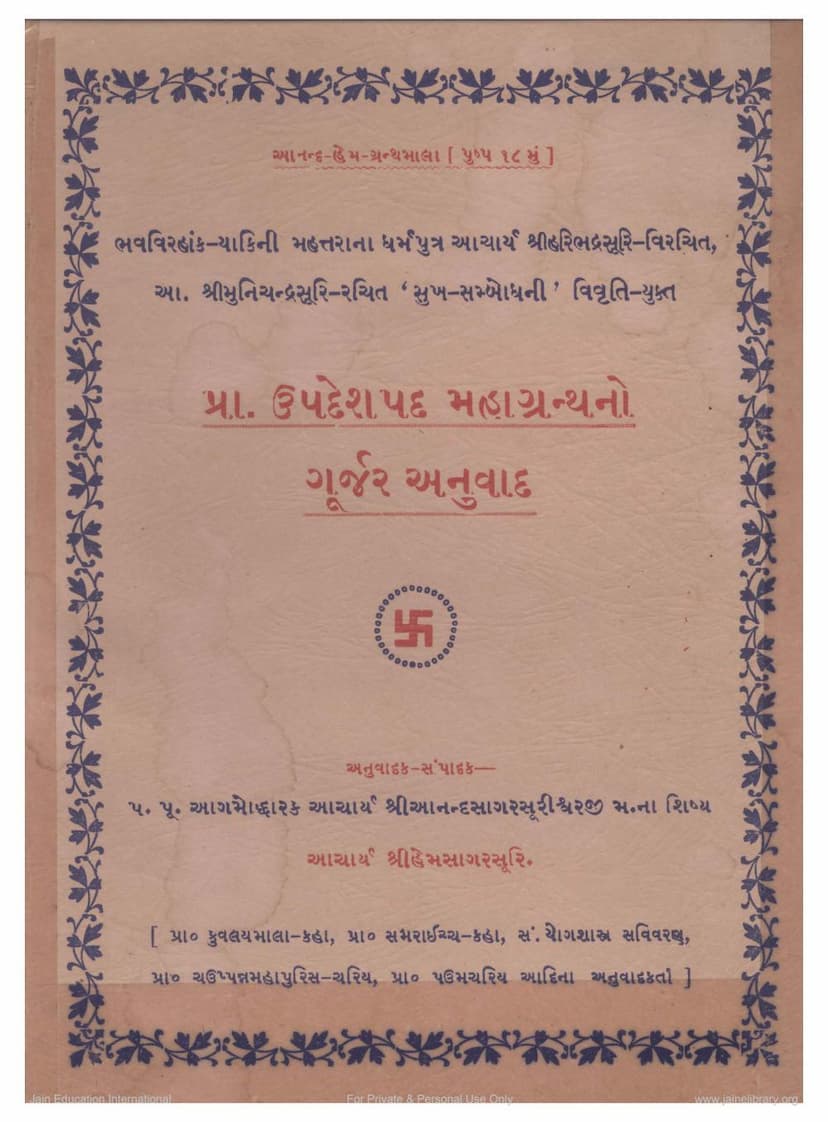Prakrit Updeshpad Mahagranth Gurjar Anuwad
Added to library: September 2, 2025

Summary
This Jain text, "Prakrit Updeshpad Mahagranth Gurjar Anuwad" (Gujarati translation of the Great Compendium of Prakrit Precepts), is a significant Jain scripture compiled by prominent Jain Acharyas: Haribhadrasuri, Munichandrasuri, and Hemsagarsuri, with a translation and editing contribution by Acharya Hemsagarsuri and co-editor Pandit Lalchandra Bhagwandas Gandhi. Published by Anand Hem Granthmala, this work is a Gujarati translation of the original Prakrit text, "Updeshpad Mahagranth," which contains approximately 1039 verses.
The text begins with a profound explanation of the arduous journey of the soul through the cycle of birth and death (samsara), highlighting the rarity and preciousness of human life. It emphasizes the importance of spiritual guidance from enlightened teachers and the profound significance of Shruta Jnana (scriptural knowledge) as a means to understand the true nature of the soul, karma, and the path to liberation.
Key Themes and Content:
-
The Rarity of Human Life: The text underscores the extreme difficulty of attaining human birth, which is considered a gateway to spiritual realization. It uses various analogies to illustrate this preciousness, urging readers to utilize their human life for Dharma.
-
The Role of Gurus and Shruta Jnana: It stresses the indispensability of enlightened gurus and the profound wisdom contained within Jain scriptures (Agamas). The text explains that true understanding comes from learning from a guru with humility and devotion, as mere intellectual knowledge without spiritual insight is ineffective.
-
The Nature of Shruta Jnana: The summary distinguishes Shruta Jnana from Kevala Jnana (omniscience), explaining that while Kevala Jnana is absolute, Shruta Jnana, received through scriptures and gurus, is the basis for propagating knowledge and performing acts of compassion for the welfare of others. The text highlights the significance of the Dvadasangi (twelve limbs of Jain scripture) and the Chaturdasha Purva (fourteen ancient texts) as foundational elements.
-
The Importance of Interpretation and Commentary: The text discusses the commentaries on the original work, specifically mentioning the "Sukha Sambodhni" commentary by Acharya Munichandrasuri. It notes that the original Prakrit text, along with its Sanskrit commentary, is extensive (around 14,500 verses), necessitating a Gujarati translation for wider accessibility.
-
The Authors and Their Contributions: It provides a brief introduction to the principal authors, highlighting Acharya Haribhadrasuri's prolific writing (over 1400 texts) and his reputation as a great exponent of Dharma. Acharya Munichandrasuri is recognized for his insightful commentary, and Acharya Hemsagarsuri is noted for his extensive translational work in Prakrit and Sanskrit literature, including this volume. Pandit Lalchandra Bhagwandas Gandhi's role as a meticulous co-editor and proofreader is also acknowledged.
-
Content of Updeshpad: The text outlines the diverse topics covered in "Updeshpad," including:
- Ten examples illustrating the rarity of human life.
- Discussions on different types of intellect and their qualities.
- The protection of Shila (virtuous conduct) by figures like Ratisundari, Riddhisundari, Buddhisundari, and Guṇasundari.
- Examples of practical application of Dharma, such as guru-residence, fasting, and the methods of teaching and learning religious principles.
- Discussions on Vakyartha, Mahavakayartha, and Audharya.
- The importance of Vinaya (humility and respect) in gaining spiritual knowledge.
-
Historical Context and Manuscripts: The text references ancient manuscripts of "Updeshpad" dating back to the 12th century Vikram Samvat (around 1135 CE) found in the Jaisalmer Bhandar, indicating the antiquity of the text and its commentaries. It also mentions the commentary by Vardhamansuri (Vikram Samvat 1055), which remains unpublished.
-
The Commentary "Sukha Sambodhni": This commentary, composed in Sanskrit by Muni Chandrasuri in Vikram Samvat 1174 (around 1118 CE), is described as vast (approximately 13,500 verses) and includes both Sanskrit explanations of the Prakrit text and Prakrit verses embellished with poetic devices. The commentary begins in Nagpur and concludes in Anhilwad Patan, detailing the lineage of its author and his teachers.
-
The Translation and Publication: The Gujarati translation, undertaken by Acharya Hemsagarsuri, is presented as a crucial effort to make this profound text accessible to the Gujarati-speaking populace. The publication details, including the first edition year (1972), print run (1250 copies), and price (Rs. 15), are provided.
-
Acknowledgments: The text concludes with a list of various institutions and individuals, including disciples and patrons, whose financial and supportive contributions were instrumental in the publication of this monumental work.
In essence, "Prakrit Updeshpad Mahagranth Gurjar Anuwad" is a meticulously translated and published Jain scripture that serves as a guide to understanding the core principles of Jainism, emphasizing spiritual discipline, the importance of scriptural knowledge, and the path to liberation, all presented through the profound wisdom of ancient Jain Acharyas. The detailed content indicates a focus on practical spiritual guidance and ethical conduct derived from the foundational teachings of Jainism.